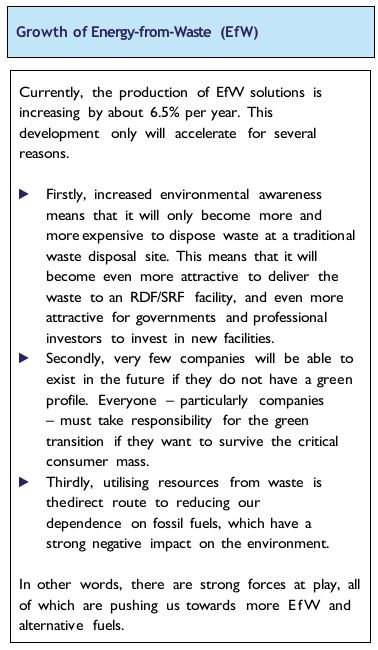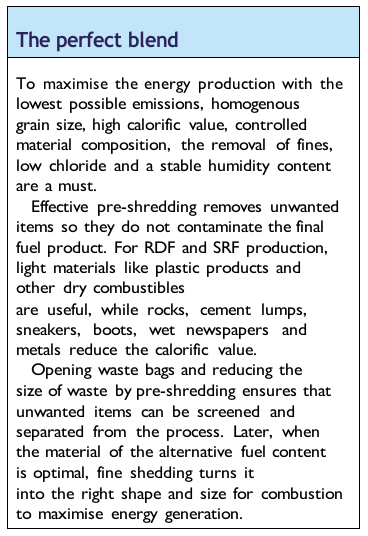On course for a circular economy
Published by Emily Thomas,
Deputy Editor
World Cement,
M&J Recycling explains the importance of alternative fuels produced from waste in the pursuit of a circular economy.
The circular economy marks a move away from the linear economy that is about producing, using and throwing away. Alternative fuels produced from waste play a crucial role in the pursuit of that vision. Alternative fuels can boost the green transition, helping to draw an economy where everything is designed for recycling and where it must be possible to separate products so that the materials can be recycled at the same value or maybe even at a higher value, which is called upcycling. However, no matter how skilled we become at reducing, reusing, and recycling, there will always be some residual waste. Despite this, it can still make a positive contribution to environmental accounts, and can be used as an alternative fuel to supply households and industries with energy – both electricity and heat.
Energy-from-Waste eliminates emissions
Energy-from-Waste (EfW) is not just a waste disposal method. It is a way of getting energy from waste, and making it into valuable resources. Energy-from-Waste is a vital part of a sustainable waste management chain and a vital part of a successful circular economy. It is one of the most robust and effective energy options to reduce CO2 emissions and replace fossil fuels such as coal, oil and natural gas.

In short, it saves the entire costly process of extracting fossil fuel and at the same time solves a waste problem. 50% of municipal solid waste goes to landfill. This releases greenhouse gasses like methane, which is 21 times more harmful than CO2. Energy-from-Waste eliminates these emissions. Approximately two thirds of household waste is categorised as biomass, therefore, we can begin to reduce our dependence on fossil fuels. “Energy-from-Waste is advantageous because it can supply energy consistently year after year. However, that requires stable production of the alternative fuel. The energy in the waste is best utilised when there is a consistent flow of homogeneous waste in smaller grain size fractions”, says Uffe Hansen, CEO at M&J Recycling.

Uffe Hansen, CEO at M&J Recycling
The optimal line design depends on the required final fuel quality, with finer grain sizes requiring additional processing to remove unwanted elements to ensure a homogenous end product. Good equipment design also takes easy maintenance and high availability into account. One of M&J’s customers, the Energy from Waste plant Bamberg in Germany, manage every year to transform 120 000 t of combustible waste to an impressive 77 525 MWh of district heating and 51 888 MWh of electricity. This proves that the environmental potential in Energy-from-Waste is gigantic.
Alternative fuel for the cement industry
Waste is normally converted into two different kinds of combustible alternative fuels, either SRF (Solid Recovered Fuel) or RDF (Refuse Derived Fuel), where SRF is especially suited for the cement industry due to the higher quality and calorific value. Alternative fuel is produced from household and commercial waste, which includes biodegradable material as well as plastic. Non-combustible materials such as glass and metal are removed and the remaining material is then shredded.
RDF is mainly used to generate energy in the form of electricity and hot water for district heating systems. SRF is produced by mechanically treating non-toxic household or industrial waste including paper, cardboard, wood, textiles and plastics. It has a higher calorific value than RDF as it has undergone further treatment to increase this. It is therefore often preferred as an extremely potent fuel for cement kilns.
Both RDF and SRF can be used in many industries, but is mainly used in EfW facilities, where it is converted through combustion into energy resources in the form of electricity, heating, cooling and fuels. It is clean production with an impressively high efficiency of up to 95% and ultra-low dioxin emission levels. Using RDF/SRF instead of fossil fuels achieves enormous benefits for the environment.
The energy is extracted from the waste as opposed to just accumulating and damaging the ecosystem. It also prevents pollution from fossil fuels such as coal and gas, which are still used in many facilities. These are huge environmental benefits.
No major investments needed
The production of cement is a highly energy-intensive process that involves significant fuel costs – approximately 30% of current expenditure can be ascribed to fuels. Increasing the use of alternative fuels such as SRF can significantly reduce these costs – and just as importantly, it can lower the industry’s considerable CO2 emissions.
According to a report by the United Nations Environment Programme a few years ago, manufacturing of building materials such as concrete is a huge culprit in the overall energy picture, and therefore an important area in which to apply sustainable solutions. The UN estimates that as much as 39% of all energy-related CO2 emissions worldwide come directly or indirectly from the construction industry – with 8% coming from the cement industry alone. In comparison, air traffic accounts for just over 2%. In other words, huge gains can, according to UN, be made in the environmental ledger by changing the cement industry’s production methods.
The cement production points in only one direction. There is an insatiable demand for this inexpensive building material, which is part of nearly every construction project. Unfortunately, though, CO2 emissions are a consequence of the approximately 1500° kilns that must run non-stop on coal and another fossil fuels.
“The good news is that multiple studies show that you can actually replace up to 30% of fossil fuels without major investments in the facility. Virtually all cement factories can do this starting from tomorrow, which in itself would be a huge benefit for the environment. The ambition for a more sustainable cement industry is most of all a matter of will. The technology is there – and so is the SRF supply”, Uffe Hansen underlines.
Must be extremely homogeneous
SRF basically looks like shredded plastic of 20 – 30 mm in size. However, it has undergone an advanced treatment process that removes biodegradable substances and leaves a solid, clean and non-hazardous fuel. SRF is manufactured to strict specifications to meet the cement plant’s requirements for kiln fuels. It typically has a moisture content below 15% and a CV (calorific value) of 18 – 22 MJ/kg. Coal is in the same range, and SRF can therefore typically replace it on a one-to-one ratio. However, it burns faster than coal, but you can adjust for this by increasing the energy input and changing the fuel settings. “The quality of SRF is of course paramount. The factory needs an extremely homogeneous product where the same levels of calorie content and calorific value are maintained across all bales and deliveries. It is a matter of fuel composition, and the shredding of fractions is particularly relevant”, Uffe Hansen concludes.

The M&J F-320

Leading cutting technology and cleverly designed rotor ensure highly efficient shredding of all suitable material.
Consistency in SRF has been a challenge in the past, but today manufacturers have mastered quality assurance, so it is no longer an excuse. Producing high quality SRF has become easier with the sophisticated technology used today. The optimal line design depends on the required final fuel quality, with finer grain sizes requiring additional processing to remove unwanted elements and ensure a homogenous end product. Good equipment design also takes easy maintenance and high availability into account.
Boosting production
M&J Recycling is very committed to contributing to the circular economy. Waste shredding is an important part of the company’s recycling effort as it provides a much more economical, efficient and environmentally sound process. M&J’s shredders help to ensure that the waste has a homogeneous output of RDF and SRF that can be seamlessly included in the further process.
The new M&J F320 is part of the robust and reliable M&J F-series of FineShredders, created to perform with minimal downtime for maintenance and servicing. It has an impressive capacity of up to 28 tph and can be easily and quickly configured for all qualified materials. This makes it particularly obvious for the cement industry, where capacity, flexibility and high operational reliability are crucial. The M&J F320 is equipped with an extra-long rotor and is very efficient in terms of operation and energy consumption. With the right applications, the high-performing M&J F320 can handle any kind of waste and ensure a stable flow of energy to the cement kilns.
Read the article online at: https://www.worldcement.com/special-reports/11032022/on-course-for-a-circular-economy/
You might also like
Rohrdorfer starts ethylene production from carbon dioxide
Following a test phase, production is to be scaled up to an industrial scale, thereby establishing a seamless CO2 circular economy.





